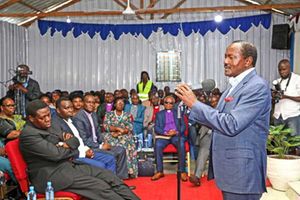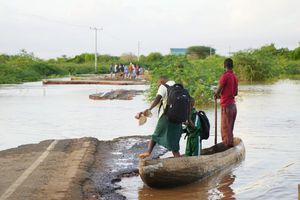New projects in Narok aim at mitigating human-animal conflict

A predator-proof cattle shed in Olderkesi, Narok West on October 6, 2021.
Pastoralists in Narok County now have a reason to smile following the installation of solar-powered flashing lights, predator-proof cattle sheds and elephant deterrent fences in bid to reduce human-wildlife conflict.
In the Maasai Mara region, villages neighboring Olderkesi, Lemek and Olkinyei conservancy have benefitted from the installation of the light-emitting diodes (LEDs) on posts around livestock enclosures in 10 manyattas in every village and a nine-kilometer elephant-deterrent within the Mara region.
Most attacks by lions, leopards, hyenas, cheetahs and jackals occur at night in the manyattas, impacting negatively on the livelihoods of the residents of the semi-arid area.
A beneficiary, Mr Mathew Ntayia, can now rest easy as his herd of 60 cattle and over 100 sheep spends the night in a newly constructed eco-friendly and secure predator-proof boma.
Some times last year, Mr Ntayia lost 30 sheep to hyenas and leopard attacks at night while his family was asleep.
According to Dr Martin Mulama, the World Wide Fund for Nature-Kenya’s (WWF-Kenya) Southern Kenya Landscape Manager, says the initiative which was funded by the BMZ German Federal Ministry of Economic Development and Cooperation is meant to improve wildlife habitat management and to mainstream environmental and social safeguards and inculcate community-drive climate smart-approaches to diversify household income-generating activities through nature-based solutions.
“The initiative also involves construction of predator-proof bomas to solve human-wildlife conflict, especially in dispersal areas along conservancies and migratory routes to Maasai Mara Game Reserve and the Serengeti national parks in the three sub-landscapes,” he added.
The predator-proof bomas are constructed using metal and wooden or poles from recycled plastic that are surrounded by triple-twist chain link and barbed wire. A steel gate is installed to control livestock entry and exit. The boma is impenetrable for large carnivores as it is sealed all round.
“Before the construction of the new boma, the return of livestock each evening marked the beginning of a long restless night of listening for any commotion and shooing away predators,” said Ntayia during an interview at his home village of Nkoirienito.
Mr Ntayia, who is also the community liaison officer for the Olderkersi Conservancy added; “The possibility of losing livestock to a hyena a leopard or other predators was very high back then. My old boma was not strong and was made of rafters and tree twigs to prevent attacks. It had many loopholes that made it easy for predators to breach and prey on my livestock. With this new shed boma, I can sleep more comfortably,” says the 37-year-old.
It’s the same feeling for Moses Karbolo of Enesiteti village not far away from Ntayia’s as he is the beneficiary of the 48 predator deterrent lights which were distributed to 10 manyattas neighboring Olderkesi conservancy.
Mr Ntayia said the area is a human-wildlife conflict-prone area because of the proximity of human settlement to wildlife conservancies like Olderkesi Conservancy, the Maasai Mara Game Reserve which lie at the border of Kenya and the Serengeti National Reserve. Humans, livestock, and wildlife share the same space.
“Most conservancies are vast and not fenced, leaving wild animals free to roam, occasionally straying into villages and attacking livestock and not once has the buffaloes and elephants cleared our five acres of maize farm in the past,” said during an interview at his home on Thursday.
Like most herders in the Mara ecosystem who say they have had their livestock preyed on by wildlife several times, Mr Ntayia said such wildlife attacks are now a thing of the past as he has lost over 50 sheep in the last two years to leopard and hyenas who creep to the villages at the fall of darkness and kill their livestock.
WWF-Kenya is among conservation organisations working in the Mara ecosystem that have devised new tactics to reduce human-wildlife conflicts in the area. Construction of the predator-proof Bomas is one such intervention.
The climate adaptation projects have been implemented in Mara, Amboseli and Tsavo sub-landscapes, benefitting thousands of community members in the wildlife-rich region.





